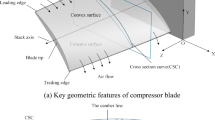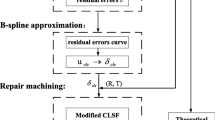Abstract
Currently, most blade repairing methods are primarily oriented for a straight or slightly curved blade; moreover, they are based on non-contact measured point-cloud, resulting in low accuracy and significant uncertainty-related issues on the defective region during repair. Therefore, this study investigates a contact measured point method with a high accuracy to analyze the repairing of a defective twisted blade; in addition, the paper proposes a new repairing method of deforming the reference cross-sectional curves adjacent to defective cross-sectional curves recursively. In order to accomplish the aforementioned, first, an interpolation algorithm of the cross-sectional curves using B-spline is set; thereafter, a criterion of the measured point density based on the size relationship between the defective region and the blade as a whole is determined. Subsequently, the registration algorithm of the reference curve and measured points of the defective cross-sectional curve to facilitate the deforming operation is provided. An iteratively moving distribution algorithm of all control points belonging to the reference curve is proposed by this paper in order to realize curve deformation. The paper presents twisted blade repairing examples and also compares the repairing surface and the designed surface to verify the validity of the proposed method. The blade repairing method proposed in this paper is aimed to guarantee a surface smooth restoration with higher accuracy and offers good conditions for several designing and repairing cases.
Similar content being viewed by others
References
Yilmaz O, Gindy N, Gao J (2010) A repair and overhaul methodology for aeroengine components. Robot Comput Integr Manuf 26(2):190–201. https://doi.org/10.1016/j.rcim.2009.07.001
Bagci E (2009) Reverse engineering applications for recovery of broken or worn parts and re-manufacturing: three case studies. Adv Eng Softw 40(6):407–418. https://doi.org/10.1016/j.advengsoft.2008.07.003
Mazur Z, Garcia-Illescas R, Aguirre-Romano J, Perez-Rodriguez N (2008) Steam turbine blade failure analysis. Eng Fail Anal 15(1):129–141. https://doi.org/10.1016/j.engfailanal.2006.11.018
Gao J, Chen X, Yilmaz O, Gindy N (2008) An integrated adaptive repair solution for complex aerospace components through geometry reconstruction. Int J Adv Manuf Technol 36(11–12):1170–1179. https://doi.org/10.1007/s00170-006-0923-6
Lyu X, Yu H, Wu J (2017) Surface reconstruction for thin aero engine blade from disorganized contact measured points. Proc Inst Mech Eng C J Mech Eng Sci:095440621769200. https://doi.org/10.1177/0954406217692007
Mohaghegh K, Sadeghi MH, Abdullah A (2007) Reverse engineering of turbine blades based on design intent. Int J Adv Manuf Technol 32(9):1009–1020. https://doi.org/10.1007/s00170-006-0406-9
Mohaghegh K, Sadeghi MH, Abdullah A, Boutorabi R (2010) Improvement of reverse-engineered turbine blades using construction geometry. Int J Adv Manuf Technol 49(5–8):675–687. https://doi.org/10.1007/s00170-009-2409-9
Rong Y, Xu J, Sun Y (2014) A surface reconstruction strategy based on deformable template for repairing damaged turbine blades. Proceed Inst Mech Eng, Part G: J Aerosp Eng 228(12):2358–2370. https://doi.org/10.1177/0954410013517091
Ng BT-J, Lin W-J, Chen X, Gong Z, Zhang J (2004) Intelligent system for turbine blade overhaul using robust profile re-construction algorithm. Paper presented at the 8th International Conference on Control, Automation, Robotics and Vision, Kunming, China, Dec 6-9
Wang T, Ding H, Wang H, Tang J (2015) Virtual remanufacturing: cross-section curve reconstruction for repairing a tip-defective blade. Proc Inst Mech Eng C J Mech Eng Sci 229(17):3141–3152. https://doi.org/10.1177/0954406214567135
Brinksmeier E, Berger U, Janssen R (1998) Advanced mechatronic technology for turbine blades maintenance. Paper presented at the First IEE/IMechE International Conference on Power Station Maintenance—Profitability Through Reliability, Edinburgh, UK, march 30 -April 1
Bremer C (2000) Adaptive strategies for manufacturing and repair of blades and Blisks. Paper presented at the Manufacturing Materials and Metallurgy; Ceramics; Structures and Dynamics; Controls, Diagnostics and Instrumentation; Education, Munich, Germany, May 8–11
Dix B (2004) Aerofoil machining and polishing combined into a single automated process. Int J Aircr Eng Aerosp Technol 76 (5). https://doi.org/10.1108/aeat.2004.12776eab.005
Gao J, Chen X, Zheng D, Yilmaz O, Gindy N (2006) Adaptive restoration of complex geometry parts through reverse engineering application. Adv Eng Softw 37(9):592–600. https://doi.org/10.1016/j.advengsoft.2006.01.007
Gao J, Wen H, Wu H, Lin Z, Li S, Chen Y, He Y (2017) Geometric model reconstruction through a surface extension algorithm for remanufacturing of twist blade. Rapid Prototyp J 23(2):382–390. https://doi.org/10.1108/rpj-11-2015-0179
Wang T, Wang LW, Liu YL, Wang H, Tang J (2012) Digitally reverse modeling for the repair of blades in aero-engines. Appl Mech Mater 141:258–263. https://doi.org/10.4028/www.scientific.net/AMM.141.258
Wang LW, Wang H, Cai ZJ (2012) 3D model reconstruction of the broken aeroengine blade based on multi-scale genetic algorithm. Adv Mater Res 479-481:2250–2254. https://doi.org/10.4028/www.scientific.net/AMR.479-481.2250
Piya C, Wilson JM (2011) Virtual repair geometric reconstruction for remanufacturing gas turbine blades. Paper presented at the ASME 2011 International Design Engineering Technical Conferences and Computers and Information in Engineering Conference, Washington, DC, USA, August 28–31
Barbero BR (2009) The recovery of design intent in reverse engineering problems. Comput Ind Eng 56(4):1265–1275. https://doi.org/10.1016/j.cie.2008.07.023
Zheng J, Li Z, Chen X (2006) Worn area modeling for automating the repair of turbine blades. Int J Adv Manuf Technol 29(9–10):1062–1067. https://doi.org/10.1007/s00170-003-1990-6
Li J, Yao F, Liu Y, Wu Y (2010) Reconstruction of broken blade geometry model based on reverse engineering. Paper presented at the The Third International Conference on Intelligent Networks and Intelligent Systems, Shenyang, China, Nov 1–3
Piegl L, Tiller W (1997) The NURBS book, 2nd edn. Springer, Berlin Heidelberg NewYork. https://doi.org/10.1007/978-3-642-59223-2
Besl PJ, McKay ND (1992) A method for registration of 3-D shapes. IEEE Trans Pattern Anal Mach Intell 14(2):239–256. https://doi.org/10.1109/34.121791
Funding
The author(s) disclosed the receipt of the following financial support for the research, authorship, and/or publication of this article: This research work was supported by a technology company of China Aerospace Corporation (Grant No. MH2016072).
Author information
Authors and Affiliations
Corresponding authors
Ethics declarations
Conflict of interest
The authors declare that they have no conflict of interest.
Rights and permissions
About this article
Cite this article
Yu, H., Lyu, X. Repair of defective 3D blade model based on deformation of adjacent non-defective cross-sectional curve. Int J Adv Manuf Technol 95, 3045–3055 (2018). https://doi.org/10.1007/s00170-017-1393-8
Received:
Accepted:
Published:
Issue Date:
DOI: https://doi.org/10.1007/s00170-017-1393-8




